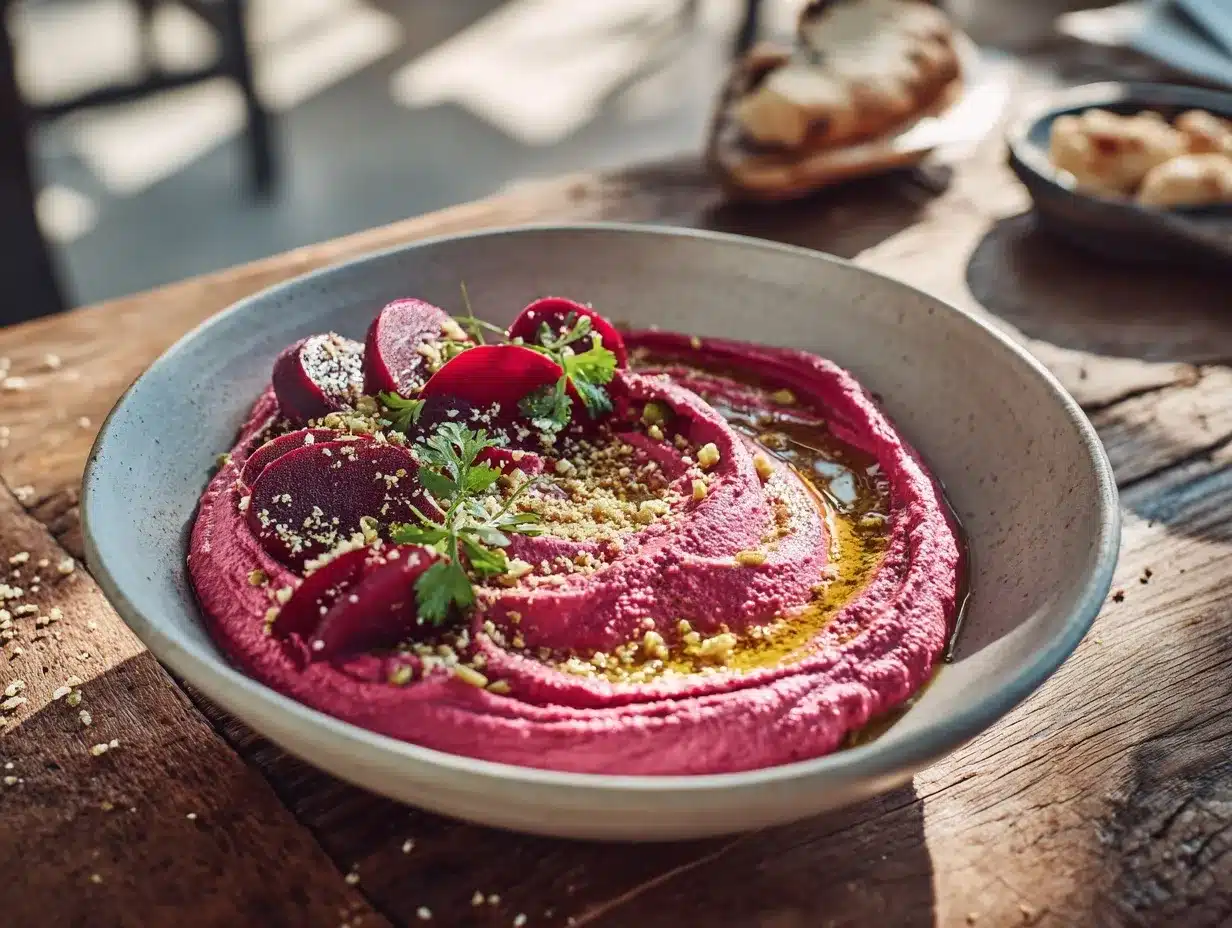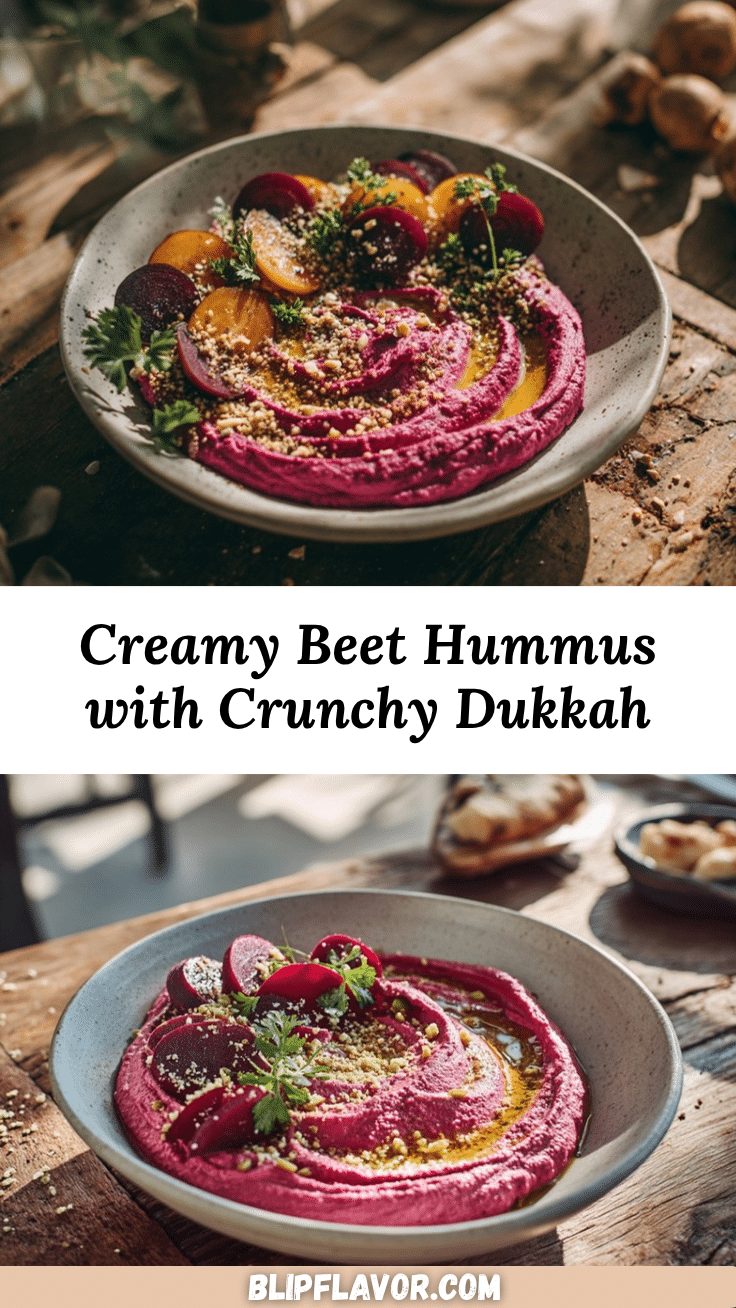Craving something vibrant, healthy, and irresistibly delicious? This beet hummus with dukkah and olive oil is a feast for both the eyes and the taste buds. The earthy sweetness of roasted beets, the creamy richness of chickpeas, and a drizzle of golden olive oil topped with nutty, aromatic dukkah make this recipe a true showstopper. Whether you’re hosting a gathering or just want to brighten up your snack game, this hummus will have everyone reaching for seconds (or thirds!).
My first time making this recipe was on a whim—I had leftover roasted beets and decided to toss them into my trusty food processor with some tahini and chickpeas. The result? A gorgeous magenta masterpiece that felt like a little bowl of edible art. Every time I make it now, I’m reminded of how simple ingredients can truly shine when you give them a little love. Let’s dive right into this delicious beet hummus recipe with dukkah and olive oil!
Why You’ll Love This Recipe
- It’s a visual delight: The bold pink hue of the beet hummus paired with the golden dukkah and olive oil creates a dish that’s almost too pretty to eat!
- A unique twist on classic hummus: The addition of roasted beets brings a subtle sweetness and earthy flavor that elevates traditional hummus to a whole new level.
- Healthy and nutrient-packed: Beets are loaded with antioxidants and essential vitamins, while chickpeas provide plant-based protein and fiber. It’s a snack you can feel good about!
- Perfect for entertaining: Whether it’s a holiday party or a casual get-together, this dish is guaranteed to impress your guests.
- Simple to make: With just a handful of ingredients, this recipe comes together in no time. Plus, it’s all made in one food processor—minimal cleanup required!
- Customizable: You can tweak the flavors to suit your taste, adding more garlic, lemon, or spice depending on your preference.
- Versatile: Serve it as a dip, spread, or even with roasted veggies—it pairs perfectly with almost everything!
Honestly, this beet hummus recipe with dukkah and olive oil is one of those dishes that feels fancy but is super easy to whip up. Let’s get started!
What Ingredients You’ll Need
This recipe uses simple, wholesome ingredients to deliver bold flavors and stunning color. You might already have most of these items in your kitchen!
- Beets: 2 medium-sized, roasted and peeled (roasting brings out their natural sweetness).
- Chickpeas: 1 cup, cooked and drained (or canned, rinsed and drained).
- Tahini: 1/4 cup (adds creaminess and nutty flavor).
- Garlic: 2 cloves, peeled (use roasted for a milder flavor).
- Lemon Juice: 2 tablespoons, freshly squeezed (brightens up the flavor).
- Olive Oil: 3 tablespoons, plus extra for drizzling (use a high-quality extra virgin olive oil for best results).
- Ground Cumin: 1 teaspoon (adds warm, earthy notes).
- Salt: 1/2 teaspoon (or more to taste).
- Dukkah: 2 tablespoons (a blend of nuts, seeds, and spices—the perfect topping).
If you’re missing an ingredient, don’t worry! This recipe is forgiving—swap out tahini for almond butter or use lime juice instead of lemon. The flavors will still be delightful.
Equipment Needed
- Food Processor: This is essential for achieving a smooth, creamy hummus. A high-speed blender works too!
- Spatula: For scraping down the sides of the food processor to ensure everything blends evenly.
- Cutting Board and Knife: To prep your ingredients like roasted beets and garlic.
- Baking Sheet: If you’re roasting fresh beets, you’ll need this.
- Small Bowls: For mixing and serving the dukkah topping.
If you don’t have a food processor, you can use a blender, though you may need to add a bit more olive oil or water to achieve the desired texture.
Preparation Method

- Preheat your oven to 400°F (200°C). Wrap the beets in aluminum foil and roast for 45-60 minutes until tender. Once cooled, peel off the skin. (Pro tip: wear gloves to avoid staining your hands!)
- In a food processor, combine the roasted beets, chickpeas, tahini, garlic, lemon juice, olive oil, cumin, and salt.
- Blend until smooth, scraping down the sides as needed. If the hummus seems too thick, add a tablespoon of water at a time until you reach your desired consistency.
- Taste and adjust seasoning. Add more lemon juice for brightness or salt to enhance the flavors.
- Spoon the hummus into a serving bowl, smoothing the top with the back of your spoon.
- Drizzle with extra olive oil and sprinkle generously with dukkah. Add a few beet slices or fresh herbs for garnish if desired.
And that’s it! Serve immediately or refrigerate for up to 5 days. Let the vibrant colors and flavors wow your crowd!
Cooking Tips & Techniques
- Roasting Beets: For the best flavor, roast the beets until fork-tender. You can also boil them, but roasting gives them a deeper sweetness.
- Avoid Over-Blending: Blend the hummus just until smooth—over-processing can make it gummy.
- Use Quality Olive Oil: A good olive oil can make all the difference, so don’t skimp on this ingredient!
- Adjust to Taste: Every beet has a slightly different sweetness, so feel free to tweak the lemon juice, garlic, or salt to suit your palate.
- Make Ahead: This hummus tastes even better after a few hours as the flavors meld together. Prepare it ahead for stress-free entertaining.
Variations & Adaptations
- Spicy Beet Hummus: Add 1/4 teaspoon cayenne pepper or a drizzle of chili oil for a kick of heat.
- Herbed Beet Hummus: Blend in a handful of fresh parsley or cilantro for a herby twist.
- Nut-Free Dukkah: Replace the nuts in the dukkah with sunflower or pumpkin seeds for an allergy-friendly version.
- Vegan Option: This recipe is naturally vegan, but make sure your dukkah doesn’t contain honey if you’re serving strict vegans.
- Roasted Garlic Beet Hummus: Swap raw garlic for roasted garlic to mellow out the flavor and add a caramelized note.
Personally, I love swapping out chickpeas for white beans sometimes—they make the hummus even creamier!
Serving & Storage Suggestions
This beet hummus with dukkah and olive oil is as versatile as it gets. Here’s how to make the most of it:
- Serving: Serve it chilled or at room temperature. Pair it with warm pita bread, fresh veggie sticks, or crackers. It also makes a great spread for sandwiches or wraps.
- Presentation: For a beautiful presentation, garnish with fresh herbs, extra dukkah, and a drizzle of olive oil. The vibrant colors make it perfect for Instagram-worthy food spreads!
- Storage: Store leftovers in an airtight container in the refrigerator for up to 5 days. Stir before serving.
- Freezing: Freeze the hummus in a sealed container for up to 3 months. Thaw in the fridge and stir well before serving.
- Reheating: While hummus is typically served cold, you can warm it gently on the stove for a unique twist.
Nutritional Information & Benefits
This beet hummus is not only delicious but also packed with health benefits. Here’s why:
- Beets: Rich in antioxidants, vitamins, and minerals that support heart health and reduce inflammation.
- Chickpeas: A great source of plant-based protein and fiber for healthy digestion.
- Olive Oil: Loaded with healthy fats that promote brain and heart health.
- Low-Calorie Snack: Perfect for guilt-free indulgence!
Each serving is approximately 120 calories, with 6g of protein, 8g of healthy fats, and 6g of fiber. It’s naturally gluten-free, dairy-free, and vegan, making it suitable for a wide range of diets.
Conclusion
If you’re looking for a recipe that’s as beautiful as it is tasty, this beet hummus with dukkah and olive oil is your answer. I love how it combines bold flavors with wholesome ingredients—it’s truly a joy to make and share. Whether you’re hosting a dinner party or simply treating yourself to a colorful snack, this recipe is sure to brighten up your table and your day.
Give it a try, experiment with your favorite variations, and let me know how it turns out for you. I’d love to hear your thoughts in the comments below! Don’t forget to share this recipe with your friends and family—they’ll thank you for it.
Happy cooking!
FAQs
Can I use canned beets instead of roasted?
Absolutely! While roasted beets bring out a deeper flavor, canned beets work just fine. Be sure to drain them well before blending.
What is dukkah, and can I make it at home?
Dukkah is a Middle Eastern spice blend made from nuts, seeds, and spices. You can easily make your own by toasting ingredients like sesame seeds, coriander seeds, cumin, and nuts, then grinding them together.
How do I make this hummus smoother?
Make sure to peel your chickpeas before blending—it takes a little extra time, but the result is ultra-creamy hummus!
Can I freeze beet hummus?
Yes, you can freeze beet hummus in an airtight container for up to 3 months. Let it thaw in the fridge overnight and stir well before serving.
What can I eat with beet hummus?
It pairs wonderfully with fresh veggies like carrots, cucumber, and celery. You can also serve it with pita bread, crackers, or as a spread for sandwiches and wraps.
Pin This Recipe!

Delicious Beet Hummus Recipe with Dukkah & Olive Oil
This vibrant beet hummus with dukkah and olive oil combines the earthy sweetness of roasted beets, creamy chickpeas, and nutty dukkah for a stunning and healthy dish.
- Prep Time: 15 minutes
- Cook Time: 60 minutes
- Total Time: 75 minutes
- Yield: 4 servings 1x
- Category: Appetizer
- Cuisine: Middle Eastern
Ingredients
- 2 medium-sized beets, roasted and peeled
- 1 cup cooked chickpeas, drained (or canned, rinsed and drained)
- 1/4 cup tahini
- 2 cloves garlic, peeled
- 2 tablespoons freshly squeezed lemon juice
- 3 tablespoons olive oil, plus extra for drizzling
- 1 teaspoon ground cumin
- 1/2 teaspoon salt (or more to taste)
- 2 tablespoons dukkah
Instructions
- Preheat your oven to 400°F (200°C). Wrap the beets in aluminum foil and roast for 45-60 minutes until tender. Once cooled, peel off the skin.
- In a food processor, combine the roasted beets, chickpeas, tahini, garlic, lemon juice, olive oil, cumin, and salt.
- Blend until smooth, scraping down the sides as needed. If the hummus seems too thick, add a tablespoon of water at a time until you reach your desired consistency.
- Taste and adjust seasoning. Add more lemon juice for brightness or salt to enhance the flavors.
- Spoon the hummus into a serving bowl, smoothing the top with the back of your spoon.
- Drizzle with extra olive oil and sprinkle generously with dukkah. Add a few beet slices or fresh herbs for garnish if desired.
Notes
[‘Roasting beets enhances their natural sweetness.’, ‘Blend hummus just until smooth to avoid a gummy texture.’, ‘Use high-quality olive oil for the best flavor.’, ‘Prepare ahead of time for better flavor as it melds together.’]
Nutrition
- Serving Size: 1/4 cup
- Calories: 120
- Sugar: 4
- Sodium: 150
- Fat: 8
- Saturated Fat: 1
- Carbohydrates: 12
- Fiber: 6
- Protein: 6
Keywords: beet hummus, dukkah, olive oil, healthy snack, vegan, gluten-free, appetizer, dip, spread




